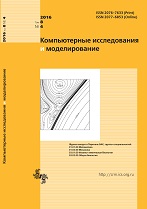|
This article is cited in 2 scientific papers (total in 2 papers)
MATHEMATICAL MODELING AND NUMERICAL SIMULATION
Global bifurcation analysis of a rational Holling system
V. A. Gaĭko
National Academy of Sciences of Belarus,
United Institute of Informatics Problems,
L. Beda st. 6-4, Minsk, 220040, Belarus
Abstract:
In this paper, we consider a quartic family of planar vector fields corresponding to a rational Holling system which models the dynamics of the populations of predators and their prey in a given ecological or biomedical system and which is a variation on the classical Lotka-Volterra system. For the latter system, the change of the prey density per unit of time per predator called the response function is proportional to the prey density. This means that there is no saturation of the predator when the amount of available prey is large. However, it is more realistic to consider a nonlinear and bounded response function, and in fact different response functions have been used in the literature to model the predator response. After algebraic transformations, the rational Holling system can be written in the form of a quartic dynamical system. To investigate the character and distribution of the singular points in the phase plane of the quartic system, we use our method the sense of which is to obtain the simplest (well-known) system by vanishing some parameters (usually field rotation parameters) of the original system and then to input these parameters successively one by one studying the dynamics of the singular points (both finite and infinite) in the phase plane. Using the obtained information on singular points and applying our geometric approach to the qualitative analysis, we study the limit cycle bifurcations of the quartic system. To control all of the limit cycle bifurcations, especially, bifurcations of multiple limit cycles, it is necessary to know the properties and combine the effects of all of the rotation parameters. It can be done by means of the Wintner-Perko termination principle stating that the maximal one-parameter family of multiple limit cycles terminates either at a singular point which is typically of the same multiplicity (cyclicity) or on a separatrix cycle which is also typically of the same multiplicity (cyclicity). Applying this principle, we prove that the quartic system (and the corresponding rational Holling system) can have at most two limit cycles surrounding one singular point.
Keywords:
rational Holling dynamical system, field rotation parameter, bifurcation, singular point, limit cycle, Wintner-Perko termination principle.
Received: 10.03.2017
Revised: 14.03.2017
Accepted: 17.04.2017
Citation:
V. A. Gaǐko, “Global bifurcation analysis of a rational Holling system”, Computer Research and Modeling, 9:4 (2017), 537–545
Linking options:
https://www.mathnet.ru/eng/crm81 https://www.mathnet.ru/eng/crm/v9/i4/p537
|

| Statistics & downloads: |
| Abstract page: | 187 | | Full-text PDF : | 57 | | References: | 25 |
|




 Contact us:
Contact us: Terms of Use
Terms of Use
 Registration to the website
Registration to the website Logotypes
Logotypes







 Citation in format
Citation in format 
